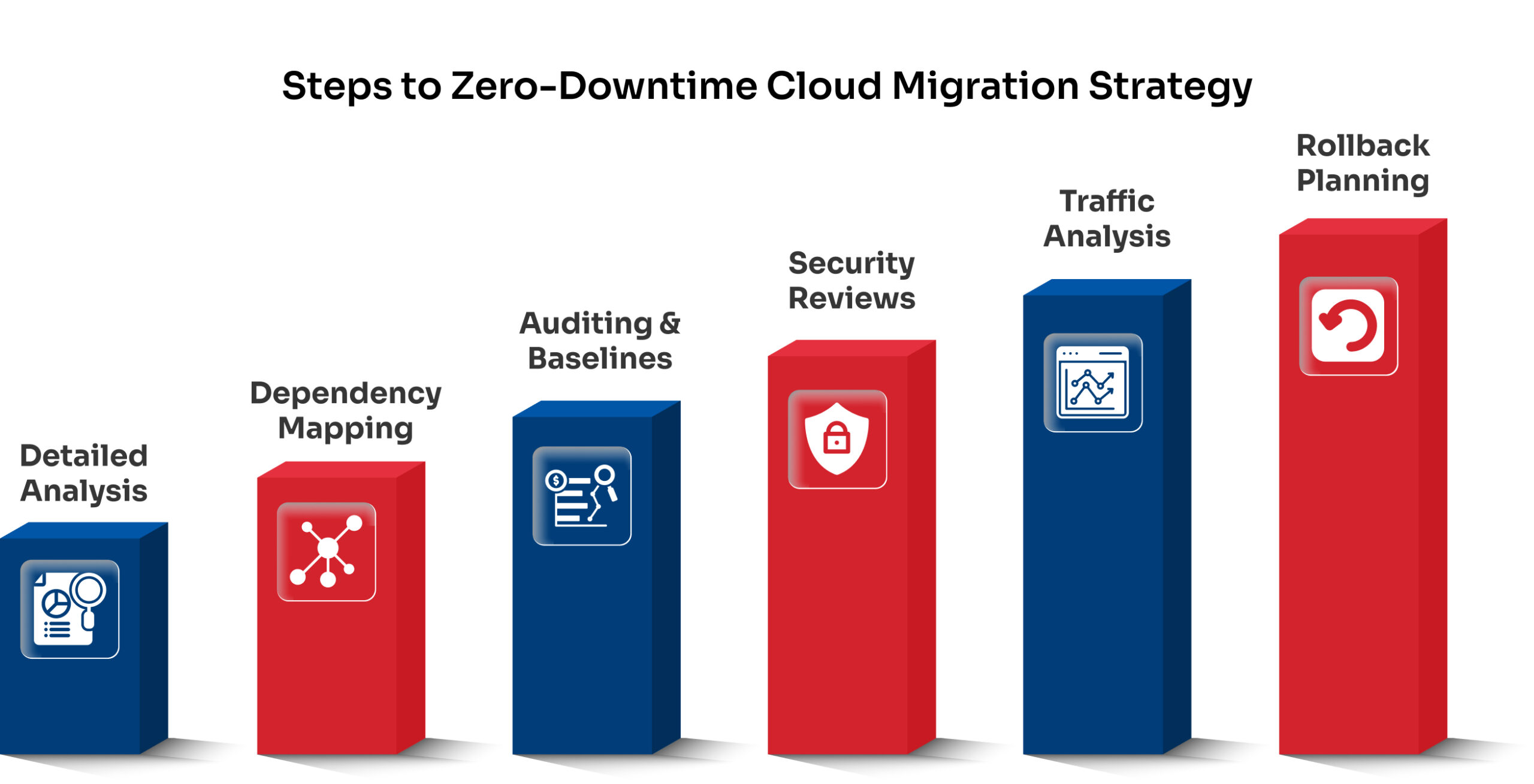For most businesses, moving to the cloud can be complicated and risky. Cloud migration doesn’t work like flipping on the switch and waiting for the best. A successful cloud migration without downtime is a well-planned strategy — often scheduled after hours, it requires extensive setup, testing, and a cutover strategy to keep the business up and running without interruption.
To ensure reasonable system performance during a transition, it is imperative to use phased approaches, rather than migrating all at once. Fortunately, working with trustworthy cloud hosting providers can ease this process. These experts offer proven frameworks and expertise tailored specifically for your business.
Our guide will take you through a systematic, step-by-step approach to cloud migration without downtime. Let’s commence with the significance of zero downtime in cloud migration.
Understanding the Business Imperative of Zero-Downtime Migration
It is a well-known fact that business continuity is the bedrock of any successful migration. Hence, achieving zero downtime during cloud migration can be challenging since it depends on application needs and the complexities involved.
Here’s where a zero downtime eases the process — but it doesn’t come without challenges, such as:
- Large data volume requires extra time for synchronization.
- Complex modifications to the database structure can introduce challenges.
- Coordinating a smooth transition becomes more intricate if application modifications are required alongside database migration.
These challenges may necessitate short interruptions and increase the likelihood of brief downtime windows.
To dissipate these challenges, your operational approach should be to focus on flawless execution. What truly determines success is not speed, but minimizing disruption through careful planning and phased execution.
Under normal circumstances, how long does a cloud migration take? Generally, the duration of a seamless migration is governed by factors such as:
- Volume of data
- Complexity of applications
- The number of dependencies
For instance, a small- or medium-sized business may require a few days or a week to complete a cloud migration. Larger organizations, on the other hand, may require several months, especially if they are dependent on legacy systems.
Furthermore, migrating too hastily continually risks service interruptions, eroding customer trust and damaging long-term goals. A rushed approach doesn’t help you scale traffic, attract new users, or grow subscribers; instead, it stalls momentum.
So, what’s the right approach to achieving zero-downtime migration in the cloud? It all begins with a good pre-migration strategy assessment — which we’ll explore next.
Also Read: DIY Cloud Migration Mistake: Why Going It Alone Leads to Costly Cloud Chaos
Setting the Stage With a Pre-Migration Strategic Assessment
A detailed pre-migration checklist is fundamental to achieving a successful zero-downtime cloud migration.
So, what is a cloud migration strategy or checklist?
The migration strategy, basically, is the basic framework to move your IT infrastructure to a cloud environment. The checklist is a more detailed, itemized document with a list of tasks, activities, and assignments to implement each part of the strategy.
It entails:
- Detailed Analysis — To identify risks and costs and align your resources to guarantee a stable migration with less disruption
- Application Dependency Mapping — To help you understand how servers, databases, and interconnected services work together — particularly useful for migrating complicated legacy or stateful applications
- Auditing and Performance Baselining — To establish benchmarks so you can measure performance post-migration — non-negotiable steps to understand your data and enable a seamless transition and a good user experience
- Security Reviews — To assess security measures and compliance guidelines to ensure your migrated environment complies with all requisite standards and cloud best practices
- Traffic Analysis — To pinpoint low-traffic windows in order to facilitate a gradual and interruption-free zero-downtime cloud migration
- Rollback Planning — To provide a safety backup to address unexpected problems during the final transition
Next comes the real task — migration without downtime.
How to Do Cloud Migration Without Downtime?
The key lies in:
- Using phased strategies
- Maintaining real-time synchronization
- Implementing intelligent traffic redirection
- Conducting thorough testing
- Having a robust Rollback plan
Real-time synchronization is vital to ensure data consistency between the source and destination during the migration process. Similarly, conducting a thorough application dependency analysis is crucial to successfully migrating applications with interdependencies.
Leveraging smart load balancing strategies like weighted DNS Records or canary releases seamlessly redirects your user traffic to the new cloud environment. Furthermore, consistent encryption and monitoring will help fortify your cloud compliance and security requirements.
If you are looking for instant Rollbacks, it is vital to implement methodologies like the Blue-Green Deployment Strategy involving two identical environments. In comparison, however, the advanced Master/Read Replica Switch Migration allows for real zero downtime. However, this approach needs strong conflict resolution techniques and is better suited for mission-critical applications requiring nil interruption.
With planning complete, the focus shifts to execution.
How to Migrate to the Cloud With Precision and Control
1. Set up the necessary infrastructure for your new cloud environment. Make sure it is similar to your existing setup in terms of core functionalities.
2. Create a complete working copy of your current application and database, and clone them to your new cloud server.
3. Establish real-time data synchronization between your on-premise database and cloud replica to save updates between your initial copy and the final move.
4. Lower your DNS Records TTL settings 24 hours before the planned switchover to ensure faster propagation.
5. Test your cloned environment and synchronized data by identifying errors and ensuring everything functions as expected in this Parallel System Operations phase.
6. Modify the A record in your DNS settings to point to your new cloud server’s IP address for a Near-Zero-Downtime DNS Switchover, to avoid small delays due to DNS caching.
7. Reroute a small portion of application traffic to the new environment to monitor performance under load using a Gradual Traffic Shifting approach.
8. Monitor the performance of your new cloud environment with alarms and auto-scaling capabilities to manage increased load effectively.
Once the traffic has been successfully redirected, the focus shifts to ensuring ongoing stability and having a robust plan in place should any issues arise.
How to Ensure Stability With Rollback and Validation Plans
Post-migration stability with performance optimization, immediate issue resolution, and continuous monitoring contributes to the sustained success of the cloud deployment.
- Utilize cloud-specific monitoring tools to identify and address potential bottlenecks.
- Ensure your support team is ready to address any post-migration issues promptly — crucial for ensuring the effectiveness of your Backup and Recovery Plan.
- Update all documentation to reflect changes in the new database environment and support your overall Rollback Strategy.
- Check if all pages load correctly, if the site speed is consistent with expectations, and if email notifications are working as intended.
- Verify that contact forms are being submitted properly.
- Check thoroughly for 404 errors, broken links, or missing images that could impact user experience.
If anything goes wrong during this validation phase, you still have your old server running as a backup, which is the foundation of your Rollback Strategy. Once post-migration stability is confirmed, you can remove the maintenance mode if you enabled it, deactivate the old server after 48–72 hours, and adjust TTL settings back to normal.
Build Your Path to a Successful Cloud Future
Achieving zero-downtime migration demands a comprehensive approach — from careful planning and precise execution to continuous testing and post-migration fine-tuning. As businesses embrace digital transformation, implementing and refining these strategies is crucial for success in the cloud era.
And yes, it is absolutely possible to achieve cloud migration without downtime. All it takes is planning, testing, and timing. So, if you’ve been putting off cloud migration because of the fear of site disruption, now you know it can be done smoothly and safely. Get your checklist ready, start with a backup, and follow the steps patiently.
Once the move is complete, you’ll enjoy faster speeds, easier scaling, and peace of mind. Partnering with experts like CMIT Solutions in Princeton and Hightstown, New Jersey, for your zero-downtime cloud migration can provide the robust business IT solutions needed for a successful transition. Connect with us today!




